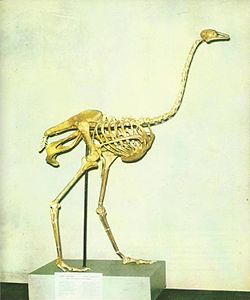| Asian ostrich Temporal range: | |
|---|---|
 | |
| Asian ostrich skeleton | |
| Scientific classification | |
| Kingdom: | Animalia |
| Phylum: | Chordata |
| Class: | Aves |
| Infraclass: | Palaeognathae |
| Order: | Struthioniformes |
| Family: | Struthionidae |
| Genus: | Struthio |
| Species: | †S. asiaticus |
| Binomial name | |
| †Struthio asiaticus Milne-Edwards, 1871 [1] | |
| Synonyms | |
| |
The Asian or Asiatic ostrich (Struthio asiaticus) is an extinct species of ostrich that lived during the Neogene period on the Indian subcontinent.
